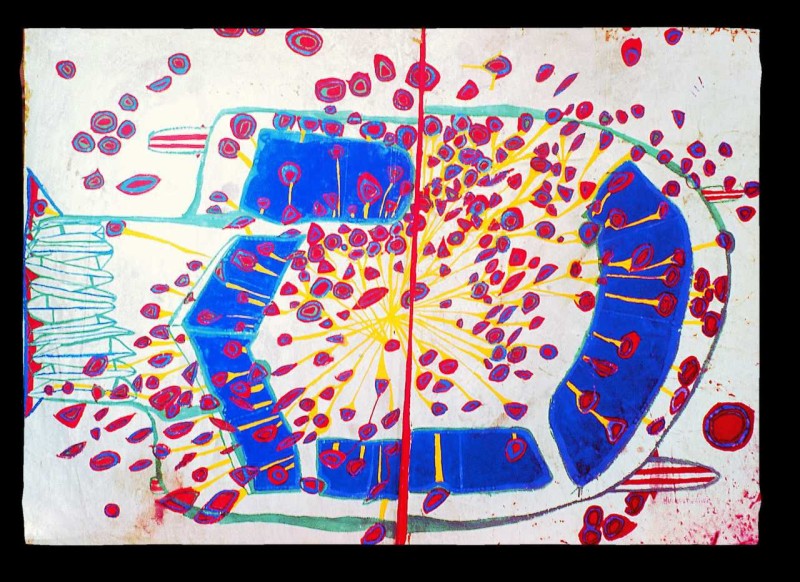153
AUTOMOBIL MIT ROTEN REGENTROPFEN I
CAR WITH RED RAINDROPS I
AUTOMOBILE AVEC DES GOUTTES DE PLUIE ROUGES I
AUTO E PIOGGIA ROSSA I
1953
Vienna, Obere Donaustrasse 12, February 1953
650 mm x 850 mm
Watercolour on two wrapping papers, primed with chalk, zinc white and fish glue, connected with a red tape
This painting remained with Ettore Colla in Rome in 1954 for the settlement of a hospitalbill for Lit. 9,000. Before that it has been with the Galleria Obelisco, Rome, in commission for Lit. 60,000
mehr weniger- Art-Club, Vienna 1953
- Travelling exhibition 1964/65:
- Kestner-Gesellschaft, Hanover, 1964
- Kunsthalle Bern, 1964
- Karl-Ernst-Osthaus-Museum, Hagen, 1964
- Stedelijk Museum, Amsterdam, 1964
- Museum des 20. Jahrhunderts, Vienna, 1965
- *
- Hammerlunds Kunsthandel, Oslo, 1965
- Studio Paul Facchetti, Paris, 1953
- Painting Box Gallery, Zurich, 1976
- Galerie Amstutz, Zurich, 1977
- W. Schmied, Hundertwasser, Feldafing, 1964 and ed. 1973, pp. 35 (c), 45
- P. Restany, Die Macht der Kunst, Hundertwasser - Der Maler-König mit den fünf Häuten, Cologne, 1998, p. 29 (c) and ed. 2018, p. 31 (c)
- R. Schediwy, Hundertwassers Häuser, Vienna, 1999, p. 66 (c)
- A. C. Fürst, Hundertwasser 1928-2000, Catalogue Raisonné, Cologne, 2002, Vol. II, pp. 240-242 (and c)
- Kestner-Gesellschaft, Hanover, 1964, pp. 14 (c), 117
- Museum des 20. Jahrhunderts, Vienna, 1965, cat. 25, p. 19
- Hammerlunds Kunsthandel, Oslo, 1965, cat. 4
- C. Garino, Vienne et le réalisme fantastique, Liestal, 1976 (c)
- Hundertwasser Bibel, Augsburg, 1995, AT, p. 629 (c)
- Arti visive, no. 8/9, May 1954, Rome (b)
- Bijutsu Techo, no. 10, Oct. 1954, Tokyo (b)
- neue generation, no. 3, May 1957, Vienna, p. 20 (b)
- Quadrum 4, Brussels, 1963 (c)
- Kunst Kultur, no. 3, Oslo, 1965, p. 135 (b)
- Postcards, St. Mandé, 1953
- Postcard, Buchheim Verlag, Feldafing, 1965 (repr.)
- Calendar 1972, Buchheim Verlag, Feldafing (January, postcard-size)
- Hundertwasser 2004 Calendar, Taschen, Cologne

Hundertwasser's comment on the work
Part of my answer to the Viennese critic Jörg Lampe, who absolutely would not understand the meaning of my painting. "Have you ever thought of this: if the rain fell in red drops and the painter or person ran outside with festive heart, spread out a white piece of paper and listened to the rhythm of the falling drops with their own ears and were witnesses of the supreme law with their own eyes . . .But we are no longer capable of counting the raindrops which fall on our face . . . We distance ourselves from the earth by haughtily sitting on chairs; we are ashamed of the cracks which form on Vienna's sidewalks, of the signs the earth brings back to us, which re-connect us to life, which we have rejected." (Letter to a Viennese Critic, written in 1953, from: Cat. Museum Ludwig, Cologne, 1980, p. 109f.)
At the time I was having a dispute with a critic in Vienna. To make Tachism comprehensible to him - this was in 1952, quite a long time ago - I wanted to prove how beautiful it would be if the rain fell in red drops. That would be especially clear if the red raindrops fell on a white limousine and left behind yellow rivulets. But this critic had taken it to mean that I wanted to make him run outside in his pyjamas every time it started to rain, to look at the spots the rain made. You can learn from the rain: when it rains you should go out in the street and position your head so the raindrops fall on your face. You should count the raindrops that fall on your face, and then you will experience the feeling of joy - especially at the first raindrops. But the critic took this the wrong way. He thought I was making fun of him and wanted him to run outside in his pyjamas. He couldn't comprehend that I was talking about something solemn. I just wanted to give him introductory instruction in Tachism. Since I was never a Tachist, I of course tried in my own way to come to grips with the problem of Tachism. These red splotches on the picture are not spilled paint, they are painted. I probably did let the core of the drops simply drop onto the paper, sure, but the edging around the individual drops is painted. In the picture a white limousine is seen from above, from the first storey of a building, say. You can see precisely how the drops stand out against the roof of the limousine and on the sidewalk. The bonnet, the four wheels and the windows of the car are visible - and the rivulets which the raindrops form. At the time I was pre-occupied with the problem of Tachism. I felt it was a major turning point. But I never succumbed to Tachism, I solved it like here in this picture. I am of the opinion that rain is Tachism to perfection. Only people don't see that correctly, unfortunately, for when it rains longer, everything gets equally wet. But if you could colour rain red and interrupt the rain after the first drops, you would have a perfect Tachistic doctrine of form. (from: Hundertwasser, Buchheim Verlag, Feldafing, 1964 and ed. 1973, p. 34)